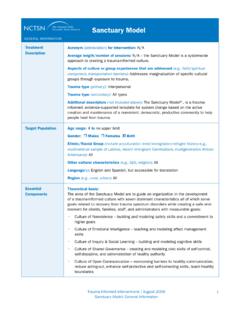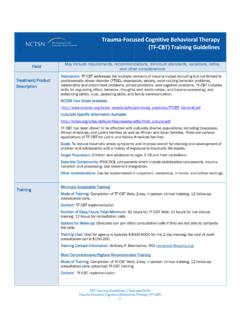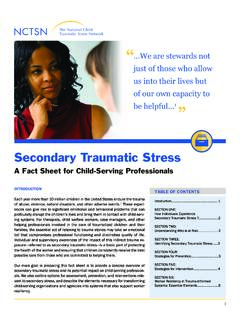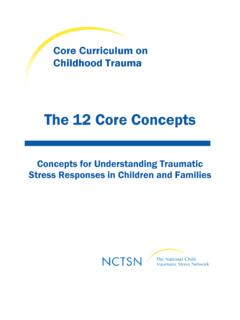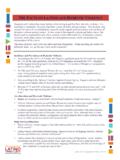Transcription of ABC: Attachment and Biobehavioral Catch-up
1 1 Trauma-Informed Interventions | April 2012 ABC: General InformationABC: Attachment and Biobehavioral Catch-upGENERAL INFORMATIONT reatment DescriptionAcronym (abbreviation) for intervention: ABCA verage length/number of sessions: 10 sessions of 60-90 minutes per sessionAspects of culture or group experiences that are addressed ( , faith/spiritual component, transportation barriers): ABC was developed primarily for use with low-income African-American, Hispanic, and non-Hispanic White families. A version of the intervention was also developed specifically for young children in foster type (primary): NeglectTrauma type (secondary): Abuse, domestic violence, placement instabilityTarget PopulationAge range: Birth to 24 monthsGender: r Males r Females r BothEthnic/Racial Group (include acculturation level/immigration/refugee , multinational sample of Latinos, recent immigrant Cambodians, multigeneration African Americans): ABC was developed and adapted for African-American, Hispanic, and non-Hispanic White families.
2 It has been used with single parent families, as well as two parent and multigenerational families. Language(s): ABC has been implemented in English, Spanish, and Norwegian, but manual only exists in English at this ( , rural, urban): ABC has been implemented primarily in urban settings, but could be implemented in rural settings as ComponentsTheoretical basis: ABC is based in Attachment theory, as well as in stress components: 1. Children who have experienced early adversity especially need nurturing care. ABC helps parents provide nurturing care even if children fail to elicit it and/or it does not come naturally to Children who have experienced early adversity are often dysregulated behaviorally and biologically.
3 ABC helps parents behave in synchronous ways that help children develop optimal regulatory Parents often behave in frightening ways that serve to dysregulate children s behavior. ABC helps parents reduce frightening & Anecdotal EvidenceAre you aware of any suggestion/evidence that this treatment may be harmful? r Yes r No r UncertainExtent to which cultural issues have been described in writings about this intervention (scale of 1-5 where 1=not at all to 5=all the time). 3xxThe National Child Traumatic Stress INFORMATIONABC: Attachment and Biobehavioral Catch-upClinical & Anecdotal Evidence continuedThis intervention is being used on the basis of anecdotes and personal communications only (no writings) that suggest its value with this group.
4 R Yes r No Are there any anecdotes describing satisfaction with treatment, drop-out rates ( , quarterly/annual reports)? r Yes r No Has this intervention been presented at scientific meetings? r Yes r No If YES, please include citation(s) from last five presentations: Conference presentations have been published in the scientific literature and are cited there any general writings which describe the components of the intervention or how to administer it? r Yes r NoIf YES, please include citation: Please see list the intervention been replicated anywhere?
5 R Yes r NoResearch EvidenceSample Size (N) and Breakdown (by gender, ethnicity, other cultural factors)CitationPublished Case StudiesIncluded in papers cited belowRandomized Controlled Trials1 RCT with foster childrenN=150 1 RCT with neglected childrenN=15050% boys; 75% African-American, 10% HispanicBernard et al., in press; Dozier et al., 2009; Dozier et al., 2008; Dozier et al., 2006 OutcomesWhat assessments or measures are used as part of the intervention or for research purposes, if any? Attachment assessed in Strange Situation; Cortisol production assessed through salivary samples (diurnal and in Strange Situation); Problem behaviors assessed through DB/DOS; Theory of mind assessed through range of tasksxxxxx3 Trauma-Informed Interventions | April 2012 ABC: General InformationABC: Attachment and Biobehavioral Catch-upGENERAL INFORMATIONO utcomes continuedIf research studies have been conducted, what were the outcomes?
6 Fewer children in the ABC intervention developed disorganized Attachment than children randomly assigned to an alternate intervention (32 vs. 58%), as reported by Bernard et al. (in press). Children in the ABC intervention also showed more normative levels of cortisol production as measured across the day and in response to stress (Dozier et al., 2006, 2008). Several additional findings have emerged that are as yet unpublished, including better outcomes for ABC children in regulating anger in a frustrating task, developing better inhibitory control, and showing more mature theory of mind, relative to children in the control Requirements & ReadinessSpace, materials or equipment requirements?
7 Intervention conducted in families homes. Computer, videocamera, and toys requirements ( , review of taped sessions)? Review of taped sessionsTo ensure successful implementation, support should be obtained from: Mary DozierTraining Materials & RequirementsList citations for manuals or protocol descriptions and/or where manuals or protocol descriptions can be obtained. Dozier, M. (2010). Attachment and Biobehavioral Catch-up . University of Delaware: Unpublished document. Manuals are available to those receiving training and is training obtained?
8 Mary Dozier, University of DelawareWhat is the cost of training? Training plus year of weekly supervision: $5,000 Are intervention materials (handouts) available in other languages? r Yes r No Other training materials &/or requirements (not included above):Pros & Cons/ Qualitative ImpressionsWhat are the pros of this intervention over others for this specific group ( , addresses stigma re. treatment, addresses transportation barriers)? The intervention has powerful effects on Attachment and on physiology, especially given that it is relatively brief.
9 Given that it is implemented in the home, families are reached who would not be reached otherwise and skills are more easily generalized than if implemented in an are the cons of this intervention over others for this specific group ( , length of treatment, difficult to get reimbursement)? This intervention requires rather extensive supervision. Combined with the fact that it is implemented in the home, it is rather expensive to National Child Traumatic Stress : Attachment and Biobehavioral Catch-upGENERAL INFORMATIONC ontact InformationName: Mary DozierAddress: Infant-Caregiver Project, Department of Psychology, University of Delaware, Newark, DE 19716 Phone number: (302) 831-2286 Email: of randomized clinical trials:Bernard, K.
10 , Dozier, M., Bick, J., Lewis Morrarty, E., Lindhiem, O., & Carlson, E. (In press). Enhancing Attachment organization among maltreated infants: Results of a randomized clinical trial. Child , M., Lindhiem, O., Lewis, E., Bick, J., Bernard, K., & Peloso, E. (2009). Effects of a foster parent training program on children s Attachment behaviors: Preliminary evidence from a randomized clinical trial. Child and Adolescent Social Work Journal, 26, , M., Peloso, E., Lewis, E., Laurenceau, J., & Levine, S. (2008). Effects of an Attachment -based intervention on the cortisol production of infants and toddlers in foster care.


